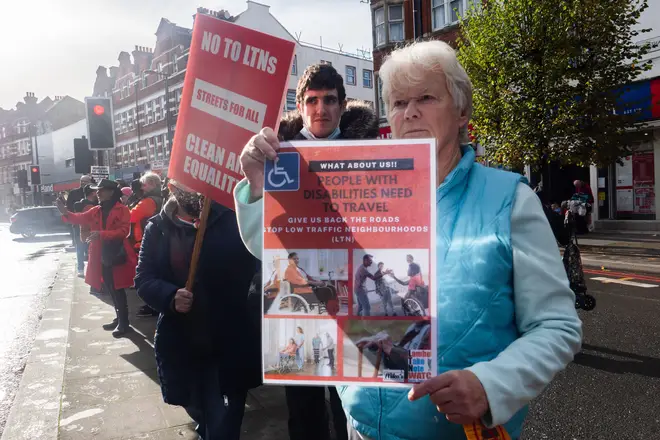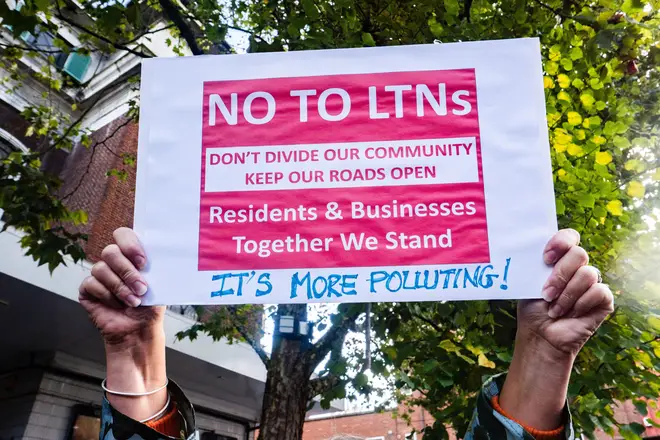
Richard Spurr 1am - 4am
29 February 2024, 10:56 | Updated: 29 February 2024, 17:02

Mayor of London reveals changes to Streatham LTN which is causing 'huge problems'
The Mayor of London has revealed changes will be coming to the Streatham Wells Low Traffic Neighbourhood which has seen huge delays to public transport and caused huge amounts of congestion.
In South London's Streatham Wells, a newly implemented low-traffic neighbourhood (LTN) has sparked significant congestion issues, causing severe delays for buses travelling along its perimeter.
During peak hours, the traffic chaos within and around the LTN has forced buses to either divert around the area or navigate through it, resulting in journeys taking up to two hours to cover less than three miles.
During a regular edition of Speak to Sadiq on LBC, London's Mayor Sadiq Khan admitted "the LTN in Streatham is causing huge problems," the Mayor said he had seen data showing an increased average time for buses in the area.
The A23 also serves as one of London's major routes between the capital and the south of England.
Mr Khan revealed his team has been in touch with Lambeth Council to "see what we can do to resolve the issues."
"It's not working and we've asked the council to look at it urgently to look at, in relation to the consequences of a very well-intentioned LTN, but people like you are reporting back to us that people are leaving your buses because it's taking so long."
"One of the unintended consequences is less use of public transport."
"You'll get some news very soon about the changes the council are going to make to that LTN because the evidence is that in the first few months, it's not been great."
A Lambeth Council spokesperson told LBC: “We are aware of concerns regarding bus times in Streatham relating to the trial of Streatham Wells LTN, ongoing roadworks by utilities and recent rail strikes. We are working closely with TfL to monitor the situation and discuss changes to the LTN.”


Recent data from Transport for London highlights the severity of the problem.
Last week, along the A23, a major route bordering the western side of the LTN, a bus journey that should have taken 29 minutes stretched to a staggering 121 minutes for a mere 2.9 miles.
The situation has reached a point where walking would have been twice as fast for bus passengers.
The traffic issues have also led to long queues of cars forming within the LTN as residents attempt to exit onto the main road.
Read more: Carmageddon in Streatham: Botched Low Traffic Neighbourhood leaves locals fuming, including me!
TfL statistics show that a significant portion of bus services has been diverted away from the affected routes during rush hour, while others have been forced to drive through the LTN.
The increase in LTNs across the country since 2020 has sparked controversy regarding their efficacy and impact.
Lambeth Council expected the new LTN to hugely increase traffic on its boundary roads but went ahead with the scheme anyway.
Streatham this evening – a grim scene with standstill traffic, congested roads, and a wall of buses. Public transport, once reliable, is now a challenge thanks to the ill-conceived Streatham Wells LTN. @RezinaChowdhury and "experts" pushed it without residents' buy-in, claiming… pic.twitter.com/PjHPnyc7FD
— Lambethltnwatch (@lambethltnwatch) February 23, 2024
In a risk assessment before the LTN was introduced, officials noted that it was “very likely” that the scheme would have a “significant impact” on traffic levels on nearby roads.
Yet despite this assessment, the same officials concluded that local buses were “unlikely” to be affected.
Bus operators say they were not consulted about the plans.
Avoid Leigham Court Rd. Fri 8pm. Car has t-boned a bus, no-one hurt. No clue of my options to get home easily, no buses thru, all other routes blocked by TWO #ltns No contingency.
— Garrads Rd & neighbours SW16 (@LambethLook) February 23, 2024
I could cry at how unsafe & unneighbourly LTNs are😭. @lambeth_council are a disgrace. #streatham pic.twitter.com/svV4k1aXd9
However, the council has already accrued £320,000 in fines within the first three months of the LTN's operation.
As we reported yesterday, Labour-run Lambeth rakes in up to £50m in fines since introducing controversial low-traffic neighbourhoods
Initially, the council attributed the congestion to "emergency roadworks," anticipating improvement over time as road users acclimatized to the new setup.
However, Transport for London has identified the LTN as the primary cause of the delays.
The Times reported its Operations’ Network Management Control Centre recently raised an “incident”, saying the LTN was causing “serious” delays in the area.
Despite this, the transport authority maintains its support for LTNs, citing research indicating reduced traffic within the zones and only marginal increases on boundary roads.

Residents and local groups, such as Lambeth LTN Watch and the West Dulwich Action Group, have expressed frustration and concern over the council's approach.
They argue that Lambeth's implementation of LTNs disregards evidence and poses risks to public safety, particularly regarding increased accident rates.
Lambeth Council defends its decision, citing resident complaints about streets being used as shortcuts. They assert that previous LTNs have successfully reduced traffic within neighbourhoods and on boundary roads by the conclusion of the trial period.
34 years I’ve lived in Streatham Wells. NEVER, NEVER,NEVER have I seen a bus diverted along Sunnyhill Road. Lambeth Council, OPEN YOUR EYES. Suspend this LTN now!! @TfL @lambethltnwatch @lambethshambles @JohnJohnStewart @AbellioLondon @CityHallTories #scraptheltns pic.twitter.com/z4AxwClMVL
— Streatham Wells Resident 💜🐶 (@Ladyskeffers) February 21, 2024
Data from Transport for London shows that last week the A23, which runs along the western side of the LTN and is one of the main routes out of south London, became so overwhelmed that one bus took 121 minutes to travel 2.9 miles. The route was scheduled to last only 29 minutes. It would have been twice as quick for passengers to walk.
Long queues of cars are also appearing within the LTN as residents try to exit the area to turn on to the main road.
Department of Transport data also shows that three-quarters of the buses on another route diverted around the LTN during rush hour while another service forged a new path straight through it.